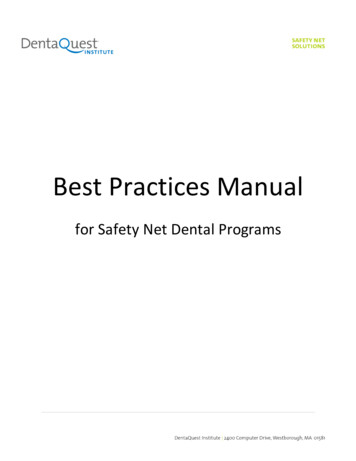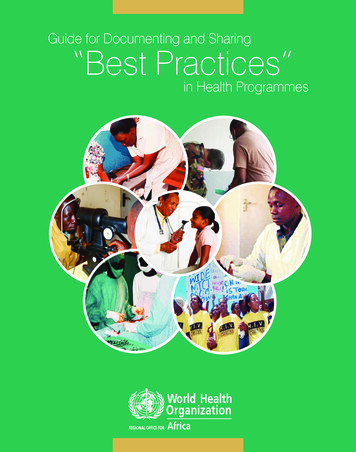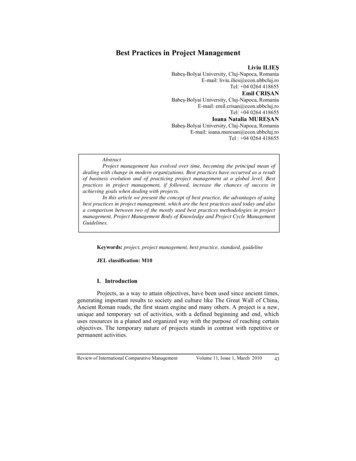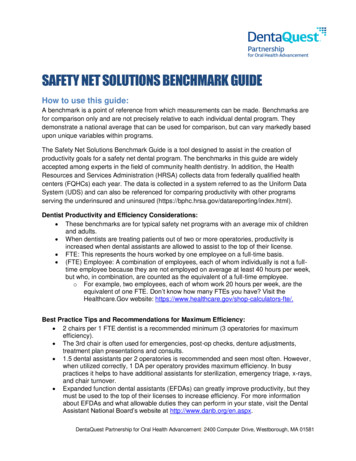
Transcription
Best Practices Manualfor Safety Net Dental Programs
TABLE OF CONTENTSKey Practice Data to Track and Monitor; and Understanding What the Data Reveals:. 3Understanding the Profit and Loss Stateme nt . 8Scheduling .10Managing Broken Appointments .11Calculating Your Broken Appointment Rate:.Managing Emergencies.13Determining Your Daily Demand for Emergency Care: .Determining Your Emergency Rate: .Billing and Collections .15Developing a Sliding Fee Discount Schedule.18Documentation of Sliding Fee Discount Schedule Eligibility.20Payer Mix:.21Determining Your Optimum Payer Mix:.Quality Management.23Phase 1 Treatment Plan Completion.26Finding Your Treatment Completion Rate.Medical Dental Integration: .28Staffing .30Leadership and Team Building: .33Program Evaluation.342 P a g e
KEY PRACTICE DATA TO TRACK AND MONITOR; ANDUNDERSTANDING WHAT THE DATA REVEALS:1. Number of dental visits: The number of dental visits within a given reportingperiod is essential information for assessing cost/visit and revenue/visit; and forcalculations regarding practice and provider productivity and service to thecommunity.2. Number of total unduplicated patients: Unduplicated patients refers to thenumber of “unique patients” cared for during the reporting period. (ie: multiplevisits by the same patient would be counted as just one unduplicated patient.) Thisnumber gives a sense of how many patients are provided access to oral healthservices. The visit/unduplicated patient ratio is typically about 2.5 visits/patient. Ifit is less than 2.5, it may point to an issue of the clinic’s limited ability to completePhase 1 treatment plans. If it is much greater than 2.5, it could represent a practiceof “unbundling services.” It can also provide an indicator of how many communityhealth center patients are receiving oral health services as compared with thepercentage of patients receiving primary care services (medical, behavioral health,etc.).3. Number of new dental patients: The number of new dental patients within a givenreporting period gives a sense of how much access is available for new patients.4. Number of emergency visits: The number of emergency visits in a given timeperiod reflects how the practice defines and manages emergencies. This datareveals how many emergencies there were compared to the number of overall visitsfor the reporting period, and also by looking at revenue vs expenses it can bedetermined if emergencies are positively or negatively affecting the bottom line. Formore information, please see the section on managing emergencies.5. Dental policies for no-shows, emergencies, scheduling, payment for dental care,and sliding fee scale: Best-in-practice dental clinics have policies governing allaspects of dental clinic operations. Equally important to having policies, they mustbe consistently enforced by all staff members. Consistent adherence to the policiesis the only way to ensure that all patients are treated equally. Any exceptions showfavoritism and are unfair. Scripting should be developed to help staff membersexplain these policies to patients clearly and with cultural sensitivity.3 P a g e
Review all dental clinic policies and look for strengths and potential weaknesses.Verify that all areas of dental care have been considered and included. If keypolicies are missing or seem to be limited, this should be addressed.6. A dental department profit and loss statement: There is a lot of essentialinformation on the P&L statement that is needed in order to complete a dentalpractice analysis. By comparing costs versus revenue, the financial sustainability (orlack thereof) of a practice is quickly ascertained.The following key data can be revealed from the Dental Department Profit and LossStatement: Gross Chargeso Benchmark: 400K- 500K per dentist per yearNet Revenueo Revenue per visitDirect/Indirect Expenseso Cost per visit Benchmark: Per 2012 UDS summary the average cost per visitfor FQHC dental clinics was 160/visitSources of Income (including 330 grant funding)Gross charges vs. net revenue (Most federally qualified health centers(FQHC’s) should have far greater gross charges than net revenue)Expense DetailsWhen a dental clinic is part of a larger health center, there are rare occasions whendental expenses and revenue are not tracked separately from the overall healthcenter. This needs to be the first thing to correct. Without clinic-specific financialinformation, you cannot monitor the dental department’s sustainability norappropriately gauge what needs to be done to achieve sustainability. Dental clinicsthat do not have dental department specific profit and loss statements shouldimmediately meet with the health center’s Chief Financial Officer (CFO) to discusstracking this information separately going forward.For guidance on understanding your profit and loss statement, see the sample profitand loss report. (**Please note that not all profit and loss statements look exactlythe same. This sample is meant to show one example of a P&L and explain some ofthe key data points that should be able to be pulled from it.)4 P a g e
7. Current dental fee schedule: The fee schedule should be evaluated annually toensure that charges are consistent with usual and customary fees for the practice’sarea (this is especially important for dental programs that are billing primarily on afee-for-service basis). Often, safety net dental clinics have set their dental fees belowwhat insurers are willing to pay for those services. For more information, pleasesee the section on developing a sliding fee discount schedule.8. Number of Completed Phase 1 Treatments and Treatment Completion Rate: Thiswill look at an important quality indicator recommended by the Health Resourcesand Service Administration (HRSA). Phase 1 treatment refers to the prevention andtreatment of dental disease. The Phase 1 treatment completion rate can be used toinfer how well the dental program is doing in relation to serving the needs of itspatient base in a manner directed toward improved patient health outcomes. Allsafety net dental clinics should place a priority on the completion of Phase 1treatment plans. Strategic planning should consider this quality indicator as a majorgoal. For more information, please see the section on Phase 1 treatment plancompletion.9. Aging Report: This report reveals how well the billing process is working within adental practice. Broken out by payer, the aging report shows how much money ispast due (by 30, 60, 90, or more days). This information can point to potentialopportunities for improvement in both billing and dental operations. Insurerstypically provide reimbursement within 60 days of the date of service, so anymoney in the “greater than 90 days” category is a red flag that there is a billing orcollection problem. Experience teaches that this problem is most likely withuncollectible claims. These claims are usually uncollectible because of unpaid debtsfrom uninsured self-pay patients or insurance claims that were denied. If there arelarge amounts outstanding, the practice needs to find out why these claims aregoing unpaid.Uncollectible claims can be reduced by: Being more diligent about verifying patient’s eligibility before providingservices for insured patientsUnderstanding the rules, regulations, and covered services of each insurerCollecting payment at the time of the visit for self-pay patientsFor more information on resolving large outstanding accounts receivable balancesand verifying insurance eligibility, please see the billing and collections section.5 P a g e
10. Broken Appointment Rate: This shows what percentage of dental patients arefailing to keep their appointments. The percentage reveals the magnitude of theproblem in a numerical manner. The overall impact on the practice can then beascertained through discussion and a look at other practice trends such as doublebooking, low numbers of completed treatments and poor staff (and patient)satisfaction. For more information, please see the section managing brokenappointments.11. Transaction Report: A transaction report (production report) shows the numberof times that each procedure was provided by ADA code. It provides keyinformation about services provided by the dental practice in the reporting period.This report reveals: The scope of services that the practice is actually providing (percentage ofdiagnostic, preventive, restorative, specialty, oral surgical, rehabilitative, andemergency treatments.)How many services are being provided at each visit? (total number oftransactions/number of visits)o Services should not be unbundled. The community standard of care needsto be upheld. An average of 2.5-3 ADA coded services/treatment visit At the periodic or comprehensive exam visit, to avoid the unbundlingof services, it is expected that the exam, cleaning, fluoride, and anyneeded radiographs would all be performed at the same visit. All sealants needed (1, 2, 3, 4 or more) at sealant visit or as part ofrecall or comp exam visit.12. Provider Productivity: Define daily productivity, financial, and outcome goals thatneed to be met; identify reports needed to evaluate dental program performance;track progress in meeting goals, and develop greater accountability through reportsand sharing of results report regularly to dental staff. Set provider productivity goals (number of visits/day and number ofprocedures/visit)o Develop and implement clinical protocols to standardize servicesprovided, maximize revenue, guard against “unbundling,” and foster thetimely completion of Phase 1 treatment plans. Productivity Benchmarks:6 P a g e
o 230 work days/year (or 1,600 work hours/year after holidays andvacations)o Dentist: 2,500-3,200 encounters/year/FTE dentist 1.7 patients/hour or 13.6 patients per day per dentist2 Chairs/dentist (3:1 is ideal) 1.5 Assistants/dentist (1 DA per chair is ideal)o Dental Hygienist: 1,300-1,600 encounters/year/FTE hygienist 8-10 patients/day for hygienists7 P a g e
UNDERSTANDINGTHEPROFITREVENUEGross ChargesSelf-PayMedicaidCommercial InsuranceOtherTotal Gross ChargesNet Allowances & Write OffsCommercial InsuranceMedicaidSelf-payBad DebtTotal Write-OffsNet Fee-for-Service RevenueTotal Patient RevenueOther IncomeGrants and Contracts (list)State330 GrantSubtotal Other IncomeTotal Operating RevenueEXPENSESDirect ExpensesPersonnel RelatedSalariesFringe BenefitsMalpractice InsuranceContracted PersonnelSubtotal Personnel CostsSupport CostsAND 100,000 500,000 70,000 - 670,000 20,361 70,000 75,000 165,361 504,639 18,750 50,000 68,750 573,389 300,000 75,000 50,000 425,000Dental Supplies 50,000Dental Lab ServicesEquipmentDepreciation of Equipment 10,0008 P a g e 5,302 5,367LOSS STATEMENTGross Charges can be used to documentthe value of the dental program to itspatients and the community it serves. Alarge gap between gross charges andnet revenue might be a signal to probedeeper into eligibility issues (ineligibleservices and/or ineligible patients).Write-offs reflect the differencebetween what the practice charges andwhat insurers reimburse. Unusuallylarge write-offs may warrant furtherinvestigation to determine the extent ofthe financial liability to the practice dueto uninsured or underinsured patients.Large write-offs in this area signal theneed to document how self-pay patientsare managed by the practice.330 Grant Allocation to dental 11%averageTotal Operating Revenue is the keyfigure used to calculate revenue pervisit.Direct Expenses are those costsassociated with the provision of dentalservices and are usually broken out assalary vs. non-salary expenses (or, inthis example, as personnel vs. supportcosts).
Continued EducationTravel-AdministrativeOffice SuppliesComputer SuppliesJanitorial SuppliesBooks SubscriptionsFees and DuesRecruitment ExpensesLeasing and ContractsData ProcessingFacility Repairs/MaintenanceEquipment MaintenanceComputer Service ContractsPayroll ProcessingLegal & AuditConsulting ServicesInsurancePrintingPostageMarketing ExpensesFundraising CostsMiscellaneous ExpensesTotal Support CostsTotal Direct ExpensesTotal Indirect ExpensesAgency AllocationTotal Indirect ExpensesTotal Expensesindirect.)Total RevenueProfit or Loss(direct 1,527 1,775 2,500 2,500 1,000 500 1,638 5,000 3,241 10,000 2,500 1,500These are the total direct costs for thedental program. 2,500 106,850This is often charged to programs forshared services such as security, IT,marketing, billing, etc. and for theservices of administrative leadership. 531,850 106,370 106,370& 638,220This is the key figure used to calculatecost per visit 573,389( 64,831)This is the key figure used to calculaterevenue per visit.This is how much the dental program islosing overall for the reporting period.9 P a g e
SCHEDULINGScheduling policies can improve the practice’s efficiency and financial sustainability whilesimultaneously reducing chaos and increasing predictability within the practice. Allpractices should create a formal policy that defines the elements of the scheduling systemthat would include elements such as: Clinical protocols that define the services to be provided by visit type Appointment time length Number of appointments available in the daily schedule to meet practice goals forpatient and payer mix. How far in advance appointments are scheduledBecause of the heavy demand for access to care in safety net dental practices, a commonbest practice is to schedule appointments out no further than 30-45 days. This helps by: Eliminating long waits for appointments Enabling providers to work patients into the schedule who are undergoingactive treatment, which in turn helps increase the number of completed Phase 1treatment plans Decreasing the likelihood of no-shows and cancellationsAnother common best practice is to schedule appointments one at a time. After a visit iscompleted, patients can make appointments for a subsequent visit until their treatmentplan is completed. Exception: patients who need a series of visits for procedures such asdentures, crowns or endodontics that are provided over multiple visits.Only allowing designated and trained staff to make appointments will provide uniformityto scheduling and prohibit tampering with the schedule by others. It is a recommendedbest practice that providers should not schedule their own appointments. This will alsoallow the schedulers to have a sense of ownership over the schedule, and leadership will beable to hold them accountable for their ability to schedule appropriately and to keep theschedule full.Design a scheduling template that manages patient and payer mix for maximum access,fosters the completion of Phase 1 treatment plans, and promotes financial sustainability.Elements to be considered in creating a scheduling template include:o The mission goals the practice has defined (i.e. treating more children,completing treatment plans, etc.).o Financial and productivity goals that the practice needs to achieve to maintainsustainability.10 P a g e
MANAGING BROKEN APPOINTMENTSIf not managed effectively, broken appointments negatively impact the productivity of thesafety net dental practice, patient continuity of care, and financial sustainability.Broken Appointments are defined as: Patients who are more than 10 minutes late for an appointment (number of minutescan be determined by the practice, but should be determined with consideration forpatient care and effect on treatment of all patients) Patients who fail to cancel an appointment at least 24 hours in advance Patients who do not present for their scheduled appointment (no show)Methods that can minimize Broken Appointments: Create and distribute a strong, no-tolerance Broken Appointment policy to establishaccountability with the patient and staff. Post signs prominently within the practiceexplaining the no-show policy. Enforce the no-show policy consistently, despite angry patients or complaints to keyhealth center leadership. In order for the policy to be effective, everyone affiliatedwith the practice must agree to support the policy. Provide scripts for staff to use for those patients who question the policy: Oneexample is: “I’m very sorry, but we have found that it is in the best interest of ourstaff members and patients to adopt this policy regarding patients who fail to keepappointments. Patient appointments in the dental practice are limited and vital tothe needs of our patients. We must preserve their use for patients who both needthem and are able and willing to show up for their scheduled appointments.”Other strategies that can be used to decrease broken appointment rates are: Have patients sign contracts to commit to the broken appointment policy Provide reminder messages to patients 48 hours prior to appointmentso Consider an automated reminder system that can call or text the patient inorder to free up the front desk staff to work on more important tasks for theday. The calls can take place after business hours when patients are homefrom work. This system can also assist with appointment confirmations byrequesting the patient confirm their appointment by responding to the textmessage. Flag patient charts of those who breach the policy and send letters reminding thosepatients of the policy they agreed to abide by. Explain policy as a part of new employee orientation and retrain staff on it once ayear at a staff meeting. Schedule appointments no further out then 30-45 days Schedule one follow-up appointment at a time for patients11 P a g e
Have emergency patients call back to schedule their follow up appointment a fewdays after the emergency visit New patients are always at high risk for being no-shows; consider strategies forreducing the potential impact of “new patient broken appointments” on the dailyschedule by limiting the number of new patients appointment slots available eachday) Do not schedule appointments for multiple family members on the same day unlessthese patients have a track record of reliability in showing up for theirappointments. (Example: Three hour-long appointments were made for threedifferent family members on the same day. If for any reason the family cannot makeit to the office that day, instead of having just one hour-long opening in the schedule,you will have three, hour-long openings in the schedule. This reduces potentialpatient access to the clinic and jeopardizes financial sustainability goals)Double-booking or triple-booking are common methods used to compensate for no-shows;however, these practices can create patient and staff dissatisfaction, disrupt clinic flow, andcontribute to a general atmosphere of chaos in the practice. For those reasons, overbookingis not a recommended practice.Track and monitor your broken appointment rate. Establish a starting point and seek tolower it. Ideal no-show rates are 15 percent or less.CALCULATING YOUR BROKEN APPOINTMENT RATE: First you must determine the number of scheduled (planned) appointments forthe reporting period.o Take the total number of patient visitso Add “no-show” appointmentso Add last-minute cancellationso Subtract walk-ins/same day appointments.Then divide the sum of all no-shows and cancellations by the number ofscheduled appointments for the reporting period.12 P a g e
MANAGING EMERGENCIESProviding emergency care is a crucial part of the mission of most safety net dental clinics,but emergencies add to overall chaos, stress and unpredictability in the practice. Thesevisits tend to reimburse poorly, and they can interfere with the care of regularly scheduledpatients. The key is to develop a system and policy for managing emergencies that enablesthe practice to accommodate the needs of emergent patients while preserving the care ofregularly scheduled patients, minimizing disruption to the practice, and maintainingfinancial sustainability. This will create an environment that promotes the completion ofPhase 1 treatment plans and fosters both patient and staff satisfaction.A well-defined emergency policy is critical to the flow of an efficient and effective dentalpractice. To develop an effective emergency policy: Define what constitutes a true emergency (pain, swelling, fever, trauma, etc.) Develop a triage form with a list of questions to ask patients that will assess theseverity of their emergency. (include a copy of the triage form in the policy) Explain the daily protocol for emergencies and what happens if all the emergencyslots are full. Also explain the protocol for after-hours emergencies.Annual training should be provided for registration and reception staff to properly triageand schedule emergency. The triage form should help staff members to correctlydetermine true emergencies. Some clinics choose to designate someone on the clinical staffwho is responsible for triaging emergencies.Use data to determine the effect of emergencies upon each individual clinic by finding outhow many emergencies the clinic typically sees per day, the amount of time that is takenout of the schedule to see emergency patients, and the types of emergencies that are seen.This will enable the practice to create an emergency policy that meets the data-determineddemand for emergency care.DETERMINING YOUR DAILY DEMAND FOR EMERGENCY CARE:The daily demand for emergency care is the average number of emergency visits perclinic day during a reporting period. Divide the total number of emergency visits (CDT codes D0140 and D9110) bythe total number of clinic days during a reporting period.13 P a g e
Create an emergency management system that meets the established level of need forlegitimate emergency care, while also preserving regularly scheduled appointments forexisting patients. Develop a strategy to efficiently accommodate emergency patients. Strategies canvary: (i.e. dedicating providers, chairs, or time slots in the daily schedule to care fortrue emergency patients). Emergency patients must be willing to come in for treatment at a time determinedby the practice, not necessarily at a time that’s convenient for themIf you find that your daily demand for emergency care exceeds your capacity to providecontinuous quality care to your existing patients, you will need to make difficult decisionsto prioritize the care you have the capacity to provide. Consider only seeing emergency patients who are patients of record of the overallhealth centerConsider only seeing emergency patients who can prove that they live within theirservice area (as defined by the zip codes used in their application for FQHC status)It is a best practice to track and monitor your emergency rate.DETERMINING YOUR EMERGENCY RATE:The emergency rate is the percentage of overall patient visits during a reporting periodthat were emergency visits. Divide the total number of emergency visits (CDT codes D0140 and D9110) by thetotal number of visits.o Note: To ensure accuracy, one of these codes must be applied at everyemergency visit – including those when definitive care is provided (such asan extraction). A 0 dummy code could also be considered for billingpurposes.14 P a g e
BILLING AND COLLECTIONSAccording to HRSA, “sound billing and collections policies and their supporting operatingprocedures are critical to a health center’s ability to carry out both the sliding fee discountprogram requirement and the requirement to maximize revenue from public and privatethird party payers.” (HRSA PIN 2014-02)Successful billing and collection practices are imperative to the financial sustainability ofthe safety net dental clinic. All safety net dental clinics should have a “Payment for DentalCare Policy” that will explain to the patient the necessity of them paying for their portion oftheir dental care. The policy should define all aspects of payment for dental care. Educateyour patients about why payment is required at the time of the visit with scripting.If your aging report shows a large amount of money in Accounts Receivable due past 90days, the billing and collection process must be reviewed and streamlined. Bring together a multidisciplinary team with representatives from dental (eg, frontdesk, dental leadership) billing, finance and others who play a role in the billingprocess to meet on a regular basis—make this a formal Billing PerformanceImprovement TeamReview the entire billing process, create a flow chart, and identify the staff person orposition responsible for each step in the processEstablish performance measures to monitor the success of the billing processProviders should take care to update and prioritize all patients’ treatment plans. That willenable reception staff to better prepare patients for their next appointment. With aprioritized treatment plan, receptionists will be able to explain to patients what they willbe coming in for and what the out-of-pocket estimated expenses will be at their next visit.When it comes to both private and public insurances, most reimbursement for oral healthservices is based upon the insurance plan’s determined eligibility of the patient to receivethose services. Practices that document eligibility appropriately can more precisely predicttheir financial outcomes by having a reasonable expectation of reimbursement for theservices they provide. It is essential that dental practices thoroughly understand eachpayer or insurer (e.g. allowable services and reimbursement rates for each coveredservice). Practices should ensure that insurance tables within the dental/medical practicemanagement system are updated and current.15 P a g e
Verify the patient’s eligibility for the specific services to be provided at every visit.Do this PRIOR to the visit.Patients should be educated on their coverage benefits and what co-payment isexpected of them. (Of course, remind them that you only have “estimates” and it isalways best for them to check directly with their insurance carrier or their HRdepartment.)Prior authorizations should be obtained for all services that require them before thepatient is scheduled an appointment to receive those services.The practice has several options to deal with non-emergent patients who show up forappointments without the proper documentation to verify their insurance eligibility: Provide services anyway (understanding the risk that these services may gounreimbursed) Provide the minimum necessary services and postpone the remainder untilcoverage can be confirmed Offer the patient the option to be either rescheduled for a time when eligibility canbe verified, or pay out of pocket for the visit. The key is to develop a formal policy for how these situations will be handled, toeducate staff and patients accordingly, and to follow through consistently. Thepractice should continuously seek to know itself better so that policy and decisionsbe based upon conscious and informed decision making.Consider the book, “Coding with Confidence: the ‘Go To’ Dental Insurance Guide,” byCharles Blair, DDS. This book helps by thoroughly explaining what each CDT code means,thereby enabling clinics to reduce coding errors and increase legitimate reimbursement fortheir services.Important Tips for Managing Self-pay Patients: Patients should receive thorough information regarding their financialresponsibilities before they receive comprehensive services. The practice shouldhave distinct policies
o Dentist: 2,500-3,200 encounters/year/FTE dentist 1.7 patients/hour or 13.6 patients per day per dentist2 Chairs/dentist (3:1 is ideal) 1.5 Assistants/dentist (1 DA per chair is ideal) o Dental Hygienist: 1,300-1,600 encounters/year/FTE hygienist 8-10 patients/day for hygienists










